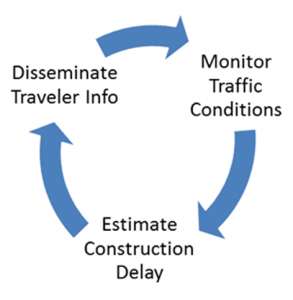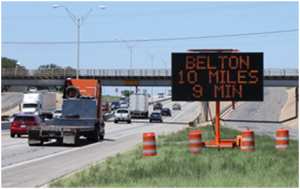
Traffic congestion is as familiar as bluebonnets on the roadside for anyone who’s traveled I-35 in the last twenty years. To meet capacity demands, the Texas Department of Transportation (TxDOT) is expanding I-35 in its Waco District (a 96-mile stretch from Hillsboro to Salado). At an estimated cost of $2.5 billion, the overall effort is made up of 17 smaller construction projects and targeted for completion in 2017.
The Texas A&M Transportation Institute (TTI) is providing TxDOT technical support on the project, namely in the form of a first-of-its-kind traveler-information system. The system integrates several methods for capturing data, forecasts congestion along the construction route, and provides that information to anyone who wants it.
The concept for the system is similar to modern traffic management systems used in urban areas. Put simply, it marries together three data-gathering methods to create reliable forecasts for travelers:
- Bluetooth® technology — travelers’ devices (e.g., cell phones, laptops, and the GPS systems in newer cars) are anonymously pinged at point A and point B, giving a reliable estimate of travel time between the points.
- Wavetronix sensors — placed strategically along the corridor at 17 points of high traffic interaction (e.g., where a state highway crosses I-35), the sensors capture traffic volume.
- End-of-queue warning systems — relying on radar detectors mounted in orange barrels around work zones, speeds of approaching vehicles are measured as they near the work zone, and patterns of slowing traffic (indicating a backup in traffic flow) are noted.
Travelers will soon be able to access reliable forecasts via My35.org for what traffic on I-35 in Waco will be in an hour, before they ever leave Hillsboro, some 40 miles away.
“From our perspective, a real success story of this project is how we’ve interfaced with TxDOT’s LoneStar traffic management system,” says TTI Research Scientist Bob Brydia, principal investigator on the project. “Using their data protocols, we feed our information to them, and that helps drive the messages you see on the PCMSs.” PCMSs, or portable changeable message signs, display traffic forecasts along the roadway.

While congestion can be inconvenient for travelers, it can also be costly — in very real terms — for big business. Knowing where work zones are, what lanes will be closed, and when to expect slower travel is vital for companies like Wal-Mart and H-E-B. They rely on I-35 to get their goods via truck from major distribution hubs to their brick-and-mortar stores. When you’re talking perishables, traffic backups can mean the difference between fresh and spoiled milk — and that can translate into lost revenue for the company and higher prices for consumers.
Similarly, with better information on hand, EMS personnel can get to the scene of an accident sooner. The life-saving potential there really needs no further explanation.
Jodi Wheatley, Waco District’s information specialist for the project, acknowledges that without TTI’s help, the I-35 expansion effort would have been much tougher.
“Reconstructing almost 100 miles of interstate is a massive job for the department, and at the end of the day we at TxDOT want to be as responsive and helpful as we can to our fellow Texans,” Wheatley says. “Because of the scope of the project, that would be much more difficult without TTI’s logistical support and technical know-how. Maybe even impossible.”